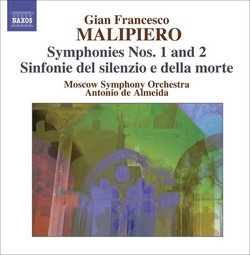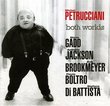| All Artists: Malipiero, Moscow Symphony Orchestra, De Almeida Title: Gian Francesco Malipiero, Vol. 2: Symphonies Nos. 1 & 2 Members Wishing: 0 Total Copies: 0 Label: Naxos Release Date: 5/26/2009 Genre: Classical Style: Symphonies Number of Discs: 1 SwapaCD Credits: 1 UPC: 747313087976 |
Search - Malipiero, Moscow Symphony Orchestra, De Almeida :: Gian Francesco Malipiero, Vol. 2: Symphonies Nos. 1 & 2
 | Malipiero, Moscow Symphony Orchestra, De Almeida Gian Francesco Malipiero, Vol. 2: Symphonies Nos. 1 & 2 Genre: Classical |
Larger Image |
CD DetailsSimilar CDs
|
CD ReviewsGreat to have 'em back, and cheap, although this one is not Discophage | France | 11/28/2009 (4 out of 5 stars) "Great that Naxos is now reissuing this series of Malipiero Symphonies, originally issued at full price on the Marco Polo label, then discontinued; many had become hard to find at a reasonable price. I had to be very patient for the original issue of this one: see my reviewMalipiero: Symphonies Nos. 1 & 2; Sinfonie del silenzio e de la morte.
Truth is, it is not the best of the series. These compositions are not entirely significant of what makes Malipiero's symphonic style so unique. "Sinfonie del Silenzio e de la Morte" is an early work from 1909-10,written in a highly-charged late-romantic style. It might appeal to amateurs of the British late-Romantics (Bax, Brian and company) or Josef Suk/Franz Schmidt, but, despite nice and evocative touches of orchestration, it is not very distinctive. Symphony No. 1 dates from the composer's maturity. It is Malipiero's "Four Seasons": it is in four movements but these have little to do with the classical model. The symphony sort of developped on its own from Malipiero's attempt to set to music poems from the cycle Le Stagioni (The Seasons) by Italian poet Anton Maria Lamberti. In the end, no words and no direct reference to Lamberti's poetry, but the notion of four movements each evoking the mood and character of a season. But I find the music rather cliched and Malipiero doesn't sound to me to have freed himself from his earlier late-Romantic influences, and I hear nothing there as strikingly original as Malipiero's later symphonies. And the same is true with the Second Symphony, "elegiaca", written three years later, in 1936. Although it bears no program other than its title, its mood and character are very much like the earlier Symphony, and again I hear nothing here as distinctive as in the Symphonies Malipiero will start composing eight years from then. Malipiero's next Symphony - No.3, "delle campane" (the bells) - was composed in 1944/5, in a time of despair: the Germans had taken over Italy and the bells of Venice pealed in announcement of doom. As is often the case, the dire situation seems to have opened up new wells of sonic imagination in Malipiero. His true originality as a symphonist started there (now that Naxos has reissued the volume with Symphonies 3 & 4, Gian Francesco Malipiero: Symphonies Nos. 3 & 4; Sinfonia del mare, even the original release can be found at a good price: Gian Francesco Malipiero: Symphonies Nos. 3 & 4; Sinfonia del mare orGian Francesco Malipiero: Symphonies Nos. 3 & 4; Sinfonia del mare). This first volume in the series can be seen only as prehistory to a fine cycle. See my review of the original release for more details." |




